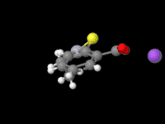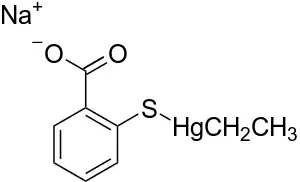Thiomersal
Thiomersal (US trademark name thimerosal, originally trademarked merthiolate)[1] is a mercury-containing compound formerly used as a preservative in many vaccines. The fact that some mercury compounds are toxic has led many in the anti-vaccination movement to conclude that vaccines containing this compound are dangerous. However, there is little evidence to support this.

Some people are afraid of thiomersal not least because it sounds chemical-y and unnatural.
In the Autism omnibus trial, it was decided that thiomersal in a MMR vaccine injection was not the cause of illness.
History
In January 1928, 42 children were injected with a diphtheria vaccine in Bundeberg, Austria. The first 21 were vaccinated from a fresh container of the TAM vaccine. Several days later, the same batch was used to inoculate a further 21 children; two days later, 12 children from this second group had died. This wasn't due to the dangers of the vaccine, but because it did not contain preservatives of any kind. The lack of an antibacterial agent in the sample of vaccine caused the second group of children to be injected with live staphylococcus bacteria, which had grown inside the batch between injecting the first group and the second. From this point on, preservatives and antibacterial agents became essential ingredients in vaccines, and thiomersal is one of several effective preservatives.[2]
It seems ironic, then, for anti-vaccination groups who want "vaccine safety" to attack one of the compounds responsible for making vaccines extremely safe.
Phase-out
In 1999, the CDC and the American Academy of Pediatrics requested a voluntary removal of thiomersal from vaccines, and today the preservative is mainly used only in seasonal flu vaccines. This may have actually encouraged anti-vaccine groups instead of shutting them up as intended, by showing them that the FDA would bend to demands and that the FDA had doubts about vaccine safety (which they didn't). This of course has also done nothing to discourage the supposed link between vaccines and autism even though the alleged cause hasn't been used as an ingredient in childhood vaccines for 15 years.
The only routine vaccines that still contains thiomersal are the influenza vaccine and one brand (Tripedia) of DPT vaccine. Almost all other vaccines have trace or no thiomersal, usually using non-mercury-compound-containing alternative preservatives.[2] Arguments against other routine vaccinations should not invoke thiomersal.
Toxicity
Mercury

Thiomersal does contain the element mercury. However, this mercury is in an ethylmercury bond (Ethyl(2-mercaptobenzoato-(2-)-O,S) mercurate(1-) sodium). Any argument involving the ingestion of 'toxic mercury' as an element may be compared an average person's daily ingestion of chlorine (a poisonous gas) through ordinary table salt (NaCl).
Many mercury compounds, particularly those with mercury-carbon bonds, are neurotoxins, such as methylmercury and dimethylmercury.[2][3] Most of the concern about thiomersal derives from analogy with methylmercury, a well-characterized mercury compound, but it is unclear whether the actual pharmacology is similar to thiomersal. Initial studies on the pharmacokinetics indicate several differences between methylmercury and thiomersal.[4]
Consider that ethanol and methanol are extremely similar molecules but have quite different effects on the body.[5]
Dosage
While in large doses thiomersal can be toxic, a 2002 study indicated that the mercury levels in infants receiving a vaccine preserved by an appropriate amount of thiomersal were low, some so trace that they could not be measured within significance. For comparison, the toxicity of mercury compounds found in fish oil pills is likely to exceed that of thiomersal. The study showed that the blood concentrations of mercury were below EPA guidelines and that the amount of mercury in stool samples was higher than normal. This indicated both that additional mercury was present (bad) and that the body was able to easily eliminate the mercury, rather than accumulate it (good).[6][7]
The amount of thimerosal actually present in vaccines is quite low and, most importantly, there are large studies available that have shown no evidence of harm.[8]
Autism
It's also interesting to note that mercury toxicity has many significant differences to the symptoms of autism. Some of the more common signs of mercury poisoning are skin discoloration/shedding, itching/burning pain in the extremities, and loss of hair/nails/teeth (pronounced in children).[9] None of these has ever been noted as an adverse effect of vaccinations stabilized by thiomersal.
See also
- Anti-vaccination movement
- Autism and pseudoscience
- Chemophobia
References
- http://www.ncbi.nlm.nih.gov/pmc/articles/PMC2376879/
- FDA.gov - Thimerosal in Vaccines
- Thimerosal in Vaccines. U.S. Food and Drug Administration (FDA). 2012 June 20.
- Burbacher TM, Shen DD, Liberato N, Grant KS, Cernichiari E, Clarkson T. Comparison of Blood and Brain Mercury Levels in Infant Monkeys Exposed to Methylmercury or Vaccines Containing Thimerosal. Environmental Health Perspectives. 005 Aug;113(8):1015-21.
- Even ten milliliters of methanol will destroy your optic nerves, causing blindness, burn holes in your brain, and kill you. Ethanol is much less toxic, as any alcoholic will tell you… after their hangover subsides.
- Pichichero ME, Cernichiari E, Lopreiato J, Treanor J. Mercury concentrations and metabolism in infants receiving vaccines containing thimerosal: a descriptive study. Lancet. 2002 Nov 30;360(9347):1737-41.
- NIAID Research on Thimerosal. National Institute of Allergy and Infectious Diseases (NIAID). 2005 April 22.
- Barile JP, Kuperminc GP, Weintraub ES, Mink JW, Thompson WW. Thimerosal exposure in early life and neuropsychological outcomes 7-10 years later. Journal Pediatric Psychology. 2012 Jan-Feb;37(1):106-18. Epub 2011 Jul 23.
- See the Wikipedia article on Mercury toxicity.